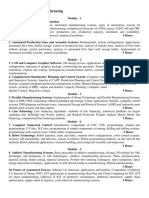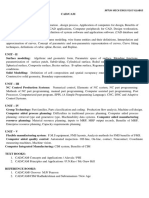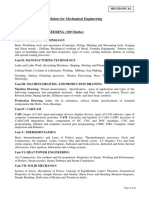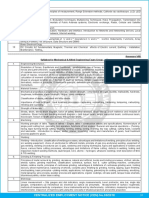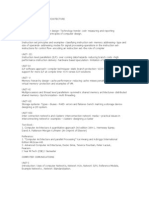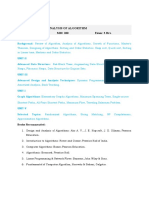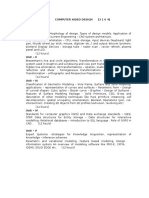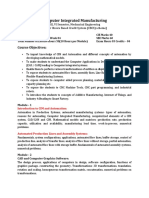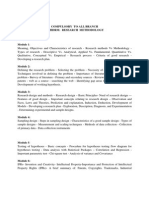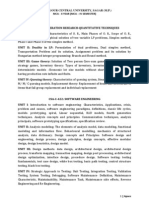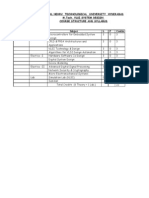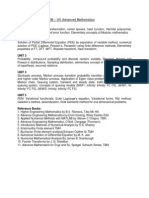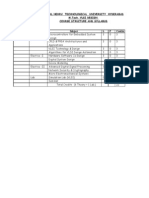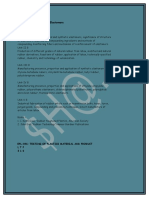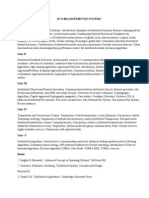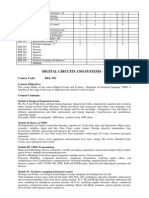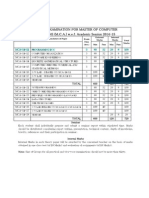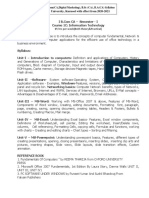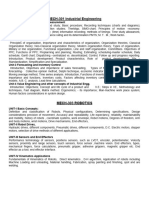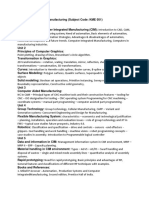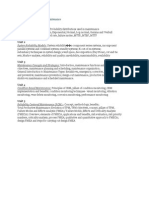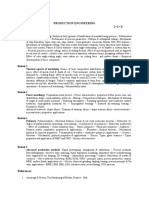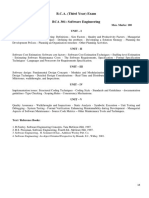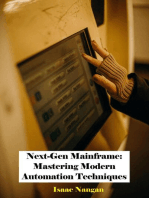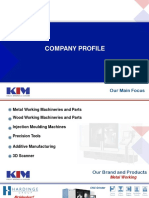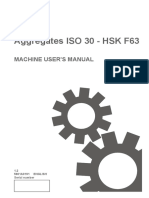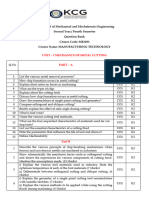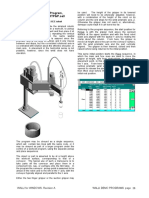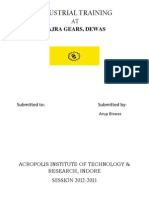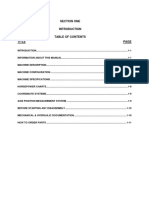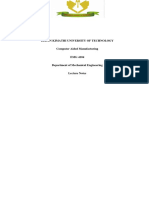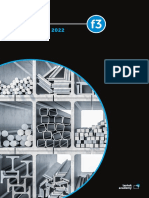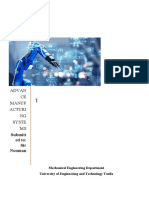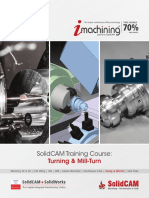Eurme 801: Cam
Eurme 801: Cam
Uploaded by
VishakhCopyright:
Available Formats
Eurme 801: Cam
Eurme 801: Cam
Uploaded by
VishakhOriginal Description:
Original Title
Copyright
Available Formats
Share this document
Did you find this document useful?
Is this content inappropriate?
Copyright:
Available Formats
Eurme 801: Cam
Eurme 801: Cam
Uploaded by
VishakhCopyright:
Available Formats
EURME 801: CAM
Unit I Numerical control production systems: Definition of NC, basic components of NC systems, types of NC control systems, NC machining centers, applications of NC, economics of NC, NC part programming methods, data feeding methods, Simple part programming for drilling and milling operations using both manual part programming and APT language, NC,CNC, DNC machines and their advantages. Unit II Production Support Machines and Systems: Automated flow lines, Methods for work part transport, transfer functions, An Overview of robotics, robot configurations, robot applications in automated manufacturing, present and future applications of robots, Automated guided vehicles(AGVs), AGV-classification, advantages and its justification, Basic components and principles of Automated Storage and Retrieval Systems(AS/RS) and applications. Unit III FMS: Definition of FMS-components, classification, work station types, Functions of material handling and storage systems, FMS layout configuration, Computer control system and its functions, Economic justification of FMS, Applications and benefits. Unit IV Group technology: Definition of GT, Part families, Methods in GT, Part classification and coding system OPTIZ, MULTI-Class coding system, Production Flow analysis, Machine cell design, Types of cell design Benefits and applications, Simple problems on GT layout formation. Unit V Computer integrated planning system : CIM, CAPP, MPS, MRP-I, MRP-II, Capacity planning, shop floor control, Problems with conventional production system, Applications of computers in manufacturing, Planning and control.CAM and their integration tools.
EURME 844: ADVANCES IN MANUFACTURING TECHNOLOGY
UNIT-I: Advanced Forming techniques: High energy rate forming, forming under hydro static pressure, forming with superimposed vibrations, forming by exploiting special material properties, tools for metal forming, Electro magnetic forming, hydro static extrusion process, thermo mechanical treatment. UNIT-II: Advanced Casting techniques: Foundry mechanization Ceramic mould casting- solid ceramic moulding, plaster mould casting, sand mould casting- Shell moulding,CO2 process, cavity less casting, Anotch casting. Casing design considerations, defects in castings. UNIT-III: Advanced Welding techniques: Electron Beam Welding, Laser Beam welding, Plasma Arc Welding, Explosive welding, Diffusion welding. Inspection of weldments, Destructive and non destructive testing. UNIT-IV: Heat Treatment & Surface Treatment of castings, forgings, weldments and powdered components. UNIT-V: Introduction to recent trends in manufacturing- Just in time, rapid proto typing, concurrent engineering, re- engineering concept, agile manufacturing, Lean production.
EURME 852: Database Management Systems
Prerequisite: File processing UNIT I: Introduction to DBMS Overview, File system vs DBMS, Advantages of DBMS, Storage data, queries, Transaction Management, DBMS Structure UNIT II: E-R model Entities, Attributes and Entity sets, Relation ship and Relation ship sets, Features of ER model, Conceptual database design with ER model. UNIT III: Relational model integrity constraints over relations and enforcement, Querying relation data, Logical database design, views, destroying/altering tables and views.Relational algebra and calculus UNIT IV: SQL Basic SQL, Query, union, interest, except, Nested Queries, Aggregated Operation, Null values, Embedded SQL, cursors, ODBC and JDBC, Triggers and Active database, designing active databases UNIT V:Transaction management, concurrency control & crash recovery Transaction concept, transactions and schedules, concurrent execution of transactions, lock based concurrency control, crash recovery. Case Study: Oracle0i (SQL, PL/SQL & Triggers)
EURME 863: Web Technology
UNITI: Introduction to Web Technology: Internet, WWW, Web Browsers, Web Servers, URL. UNIT II: Introduction to HTML & DHTML: Syntax, Forms, Cascade Style Sheets. UNIT III: The Basic of java Script, Perl, Primitives, Operator and Expression. Dynamic Document with Java Script. UNIT IV: Introduction to Java Servelets Programming., Introduction to Applet Programming. UNIT V: Structure of Web Application, Deploying Web Application.
You might also like
- The CNC Handbook: Digital Manufacturing and Automation from CNC to Industry 4.0From EverandThe CNC Handbook: Digital Manufacturing and Automation from CNC to Industry 4.0Rating: 5 out of 5 stars5/5 (1)
- Operating Manual: ZAY7032G ZAY7040G ZAY7045G ZAY7032G/1 ZAY7040G/1 ZAY7045G/1Document22 pagesOperating Manual: ZAY7032G ZAY7040G ZAY7045G ZAY7032G/1 ZAY7040G/1 ZAY7045G/1Anonymous Cx74V6ntI850% (2)
- Advanced Manufacturing SystemsDocument23 pagesAdvanced Manufacturing SystemsDhanish KumarNo ratings yet
- 18ME35A-MCF Vtu QuestionsDocument5 pages18ME35A-MCF Vtu QuestionsRakshith M100% (7)
- 14PHDME001 Advanced Manufacturing TechnologyDocument2 pages14PHDME001 Advanced Manufacturing TechnologyRing MasterNo ratings yet
- Tool Engineering Sem 2Document7 pagesTool Engineering Sem 2psg10474383No ratings yet
- Sem Ii Syllabus Jntua Mtech Embedded SystemsDocument7 pagesSem Ii Syllabus Jntua Mtech Embedded SystemsManu ManuNo ratings yet
- Jntuk M Tech r16 Cad Cam SyllabusDocument29 pagesJntuk M Tech r16 Cad Cam Syllabusvenkata100% (1)
- Cim SyllabusDocument2 pagesCim SyllabusHarish HNo ratings yet
- CAD CAM II SemDocument13 pagesCAD CAM II SemSayyadh Rahamath BabaNo ratings yet
- Jntuh Mech Engg R16 SyllabusDocument7 pagesJntuh Mech Engg R16 SyllabusAqib syedNo ratings yet
- Mechanical Engineering2024Document2 pagesMechanical Engineering2024mohdabdulnadeem8801791237No ratings yet
- ME 7th SemDocument6 pagesME 7th SemShaleen SharmaNo ratings yet
- CSE Sem 6 SyllabusDocument10 pagesCSE Sem 6 SyllabusfreefireNo ratings yet
- Me 6702 MechatronicsDocument4 pagesMe 6702 MechatronicsRAJANo ratings yet
- MRSPTU 8th Sem Syllabus 2020Document4 pagesMRSPTU 8th Sem Syllabus 2020PiyushNo ratings yet
- Department Elective-Iii: Nme-031: Computer Aided Manufacturing (Cam) L T P 3 1 0 Unit-IDocument20 pagesDepartment Elective-Iii: Nme-031: Computer Aided Manufacturing (Cam) L T P 3 1 0 Unit-IPandit Animesh TripathiNo ratings yet
- Annexure-VIID Syllabus For Mechanical & Allied Engineering Exam Group - JEDocument2 pagesAnnexure-VIID Syllabus For Mechanical & Allied Engineering Exam Group - JEVishal KumarNo ratings yet
- Advanced Computer ArchitectureDocument12 pagesAdvanced Computer Architecturegangadhar_aspnetNo ratings yet
- Syllabus For Eighth SemesterDocument4 pagesSyllabus For Eighth SemesterÂvï JâísNo ratings yet
- 6 It 4: Design and Analysis of Algorithm 3L+1T MM: 100 Exam: 3 HrsDocument8 pages6 It 4: Design and Analysis of Algorithm 3L+1T MM: 100 Exam: 3 Hrscbcbhatt1991No ratings yet
- Met71 Computer Aided Design (3 1 0 4)Document6 pagesMet71 Computer Aided Design (3 1 0 4)Anonymous kLnqFYqNo ratings yet
- Polytechnic Lecturer Computer EngineeringDocument6 pagesPolytechnic Lecturer Computer Engineeringminujose111_20572463No ratings yet
- Computer Integrated ManufacturingDocument3 pagesComputer Integrated ManufacturingsatheeshNo ratings yet
- Jawaharlal Nehru Technological University Kakinada Mechanical Engineering IV Year B.Tech. - I SemDocument3 pagesJawaharlal Nehru Technological University Kakinada Mechanical Engineering IV Year B.Tech. - I SemShobab AnuparthiNo ratings yet
- Computer Integrated Manufacturing: Course ObjectivesDocument3 pagesComputer Integrated Manufacturing: Course ObjectivesPrashanth JNo ratings yet
- My PH D SyllabusDocument7 pagesMy PH D SyllabusRing MasterNo ratings yet
- MCA IV Sem SyllabusDocument2 pagesMCA IV Sem SyllabusAnchal KesharwaniNo ratings yet
- Mtech 1 SemDocument7 pagesMtech 1 SemGarima ShuklaNo ratings yet
- CADCAMDocument50 pagesCADCAMPrem Chander100% (5)
- Vlsi System DesignDocument12 pagesVlsi System DesignNaresh BandariNo ratings yet
- First Sem PDFDocument5 pagesFirst Sem PDFRajvardhan JaidevaNo ratings yet
- Vlsi System DesignDocument12 pagesVlsi System DesignMahender GoudNo ratings yet
- Vlsi DesignDocument12 pagesVlsi DesignTanveer AhmedNo ratings yet
- EPL 034: Technology of ElastomersDocument7 pagesEPL 034: Technology of ElastomersFaiq ElNo ratings yet
- CSE 6th SyllabusDocument5 pagesCSE 6th Syllabusmanish raushanNo ratings yet
- Scheme of Examination & Syllabus: M. Sc. ElectronicsDocument24 pagesScheme of Examination & Syllabus: M. Sc. ElectronicsJacob B ChackoNo ratings yet
- 8th Sem SyllabusDocument4 pages8th Sem SyllabusShwetank GoelNo ratings yet
- MECHANICAL ENGINEERING Syllabus - Diploma StandardDocument2 pagesMECHANICAL ENGINEERING Syllabus - Diploma Standardmbsatheesh003No ratings yet
- CAD CAM SyllabusDocument2 pagesCAD CAM SyllabusDeepak AwasthiNo ratings yet
- Fifth Semester EeeDocument19 pagesFifth Semester EeeIronthroneNo ratings yet
- Scheme of Examination For Master of Computer APPLICATIONS (M.C.A.) W.E.F. Academic Session 2014-15Document11 pagesScheme of Examination For Master of Computer APPLICATIONS (M.C.A.) W.E.F. Academic Session 2014-15Siddharth JainNo ratings yet
- 4th Year - II Sem - MechDocument10 pages4th Year - II Sem - MechaareachyuthNo ratings yet
- Es IiDocument16 pagesEs IiSivasankar YalavarthyNo ratings yet
- VTU SyllabusDocument39 pagesVTU SyllabusAnilNo ratings yet
- BCom CA Semester I 2Document1 pageBCom CA Semester I 2venkataNo ratings yet
- 5th Scheme & SyllabusDocument3 pages5th Scheme & Syllabusaryan.eddie2010No ratings yet
- VLSI SyllabusDocument13 pagesVLSI SyllabusNagabhushanam KoduriNo ratings yet
- Principles of Management: HU-601 / CREDIT 2Document6 pagesPrinciples of Management: HU-601 / CREDIT 2extraincome108No ratings yet
- Computer Integrated ManufacturingDocument2 pagesComputer Integrated ManufacturingRajeevNo ratings yet
- Embedded SyallabusDocument12 pagesEmbedded SyallabusSree NivasNo ratings yet
- (Category No.125/2018) : Industries Extension OfficerDocument3 pages(Category No.125/2018) : Industries Extension OfficerVishnuprasad ParappalNo ratings yet
- Unit 1: ME-801 (C) - Reliability & MaintenanceDocument5 pagesUnit 1: ME-801 (C) - Reliability & MaintenanceAjeet VermaNo ratings yet
- Production Engineering M 801 2+1+ 0Document5 pagesProduction Engineering M 801 2+1+ 0roinbanerjiNo ratings yet
- 261 Bca 2017-18 3Document7 pages261 Bca 2017-18 3sadhnakumari9608No ratings yet
- Design Automation of Cyber-Physical SystemsFrom EverandDesign Automation of Cyber-Physical SystemsMohammad Abdullah Al FaruqueNo ratings yet
- Advances in Motion Sensing and Control for Robotic Applications: Selected Papers from the Symposium on Mechatronics, Robotics, and Control (SMRC’18)- CSME International Congress 2018, May 27-30, 2018 Toronto, CanadaFrom EverandAdvances in Motion Sensing and Control for Robotic Applications: Selected Papers from the Symposium on Mechatronics, Robotics, and Control (SMRC’18)- CSME International Congress 2018, May 27-30, 2018 Toronto, CanadaFarrokh Janabi-SharifiNo ratings yet
- Next-Gen Mainframe: Mastering Modern Automation Techniques: MainframesFrom EverandNext-Gen Mainframe: Mastering Modern Automation Techniques: MainframesNo ratings yet
- Embedded Systems: Analysis and Modeling with SysML, UML and AADLFrom EverandEmbedded Systems: Analysis and Modeling with SysML, UML and AADLFabrice KordonNo ratings yet
- The Car Hacker's Handbook: A Guide for the Penetration TesterFrom EverandThe Car Hacker's Handbook: A Guide for the Penetration TesterRating: 4 out of 5 stars4/5 (3)
- KIM Compro 2020Document16 pagesKIM Compro 2020Alfian YuandikaNo ratings yet
- Journal of Advanced Mechanical Design, Systems, and ManufacturingDocument11 pagesJournal of Advanced Mechanical Design, Systems, and ManufacturingJosé Veríssimo ToledoNo ratings yet
- Sivasakthivel PaperDocument9 pagesSivasakthivel Papersivakarthi sNo ratings yet
- CNC 5TH SemDocument8 pagesCNC 5TH SemdibyenindusNo ratings yet
- Heidenhain TNC 410 PILOTDocument82 pagesHeidenhain TNC 410 PILOTomegaNo ratings yet
- ME 6611 Lab-Manual PDFDocument61 pagesME 6611 Lab-Manual PDFgopiNo ratings yet
- Fresa Multi de Hyundai PDFDocument20 pagesFresa Multi de Hyundai PDFFabian Henao CalleNo ratings yet
- Autodesk Inventor Cad Integration HyperMILL enDocument8 pagesAutodesk Inventor Cad Integration HyperMILL enPaul VeramendiNo ratings yet
- C. AnvilDocument8 pagesC. AnvilJade Carlo AntonioNo ratings yet
- Module - Additive Manufacturing 18 SchemeDocument54 pagesModule - Additive Manufacturing 18 SchemeSANTOSHNo ratings yet
- Types MSEDocument112 pagesTypes MSESatyam KNo ratings yet
- CNC Milling: Technical DescriptionDocument15 pagesCNC Milling: Technical Descriptiongia1985No ratings yet
- Aggregates ISO 30 - HSK F63: Machine User'S ManualDocument90 pagesAggregates ISO 30 - HSK F63: Machine User'S ManualGabriel HerbeiNo ratings yet
- ME3493 - Manufacturing TechnologyDocument10 pagesME3493 - Manufacturing TechnologySriram SrinivasanNo ratings yet
- XYZ Katalog Centra 2010-2012Document20 pagesXYZ Katalog Centra 2010-2012Boutef El HachemiNo ratings yet
- WALLI Demo Files Part 3Document24 pagesWALLI Demo Files Part 3Ko_deZNo ratings yet
- Gajra GearsDocument17 pagesGajra GearsJuhi Yadav100% (2)
- B11 Tech Brief of November 2015Document14 pagesB11 Tech Brief of November 2015cesarNo ratings yet
- I XmillDocument8 pagesI XmillVladimir Pereira MacielNo ratings yet
- Sect01 Intro PDFDocument13 pagesSect01 Intro PDFAngel AdautaNo ratings yet
- CAM Notes 1Document10 pagesCAM Notes 1FELIX KEUYANo ratings yet
- JNTU R20 B.Tech - Mechnaical Engineering III IV Year Course Structure SyllabusDocument126 pagesJNTU R20 B.Tech - Mechnaical Engineering III IV Year Course Structure SyllabusHema TharunNo ratings yet
- Ilp P.gudang PDFDocument8 pagesIlp P.gudang PDFBlades DeeNo ratings yet
- Shaftloc FullDocument20 pagesShaftloc FullMrLanternNo ratings yet
- New FeaturesDocument39 pagesNew FeaturesMiroslav CajkaNo ratings yet
- Ams Lab Manual 16-Me-63Document45 pagesAms Lab Manual 16-Me-63Arslan ShabbirNo ratings yet
- SolidCAM 2015 Turning Mill Turn Training Course PDFDocument281 pagesSolidCAM 2015 Turning Mill Turn Training Course PDFPop AlecsandruNo ratings yet
- Amal Rence Vargheese Singapore 10.10 YrsDocument3 pagesAmal Rence Vargheese Singapore 10.10 Yrsmonster vjNo ratings yet








